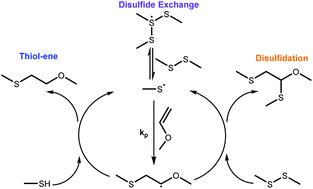当前位置:
X-MOL 学术
›
Polym. Chem.
›
论文详情
Our official English website, www.x-mol.net, welcomes your
feedback! (Note: you will need to create a separate account there.)
Radical-disulfide exchange in thiol–ene–disulfidation polymerizations
Polymer Chemistry ( IF 4.1 ) Pub Date : 2022-06-16 , DOI: 10.1039/d2py00172a Nicholas J. Bongiardina 1 , Shafer M. Soars 2 , Maciej Podgorski 3, 4 , Christopher N. Bowman 1, 4
Polymer Chemistry ( IF 4.1 ) Pub Date : 2022-06-16 , DOI: 10.1039/d2py00172a Nicholas J. Bongiardina 1 , Shafer M. Soars 2 , Maciej Podgorski 3, 4 , Christopher N. Bowman 1, 4
Affiliation

|
Radical-disulfide exchange reactions in thiol–ene–disulfide networks were evaluated for several structurally distinct thiol and disulfide containing monomers. A new dimercaptopropionate disulfide monomer was introduced to assess how different disulfide moieties affect the exchange process and how the dynamic exchange impacts polymerization. The stress relaxation rate for the disulfides studied herein was highly tunable over a narrow range of network compositions, ranging from 50% relaxation over 10 minutes to complete relaxation over a few seconds, by changing the thiol–disulfide stoichiometry or the disulfide type in the monomer. The thiol/disulfide monomer pair was shown to have significant influence on how radical-disulfide exchange impacts the polymerization rate, where pairing a more stable radical forming thiol (e.g. an alkyl thiol) with a less stable radical-forming disulfide (e.g. a dithioglycolate disulfide) reduces the rate of the thiol–ene reaction by over an order of magnitude compared to the case where those two radicals are of the same type. The variations in rates of radical-disulfide exchange with dithioglycolate and dimercaptopropionate disulfides had a significant impact on stress relaxation and polymerization stress, where the stress due to polymerization for the final dimercaptopropionate network was about 20% of the stress in the equivalent dithiogylcolate network under the same conditions. These studies provide a fundamental understanding of this polymerization scheme and enable its implementation in materials design.
中文翻译:

硫醇-烯-二硫化聚合中的自由基-二硫化物交换
硫醇-烯-二硫化物网络中的自由基-二硫化物交换反应针对几种结构不同的含硫醇和二硫化物单体进行了评估。引入了一种新的二巯基丙酸酯二硫化物单体,以评估不同的二硫化物部分如何影响交换过程以及动态交换如何影响聚合。通过改变硫醇-二硫化物化学计量或单体中的二硫化物类型,本文研究的二硫化物的应力松弛率在狭窄的网络组成范围内高度可调,范围从 10 分钟内 50% 的松弛到几秒钟内的完全松弛. 硫醇/二硫化物单体对显示出对自由基-二硫化物交换如何影响聚合速率具有显着影响,其中配对更稳定的自由基形成硫醇(例如与这两个自由基属于同一类型的情况相比,具有不太稳定的自由基形成二硫化物(例如二硫代乙醇酸二硫化物)的烷基硫醇将硫醇-烯反应的速率降低了一个数量级以上。与二硫代乙醇酸盐和二巯基丙酸盐二硫化物的自由基二硫化物交换速率的变化对应力松弛和聚合应力有显着影响,其中最终二巯基丙酸盐网络的聚合应力约为等效二硫代乙醇酸盐网络中应力的 20%。相同的条件。这些研究提供了对该聚合方案的基本理解,并使其能够在材料设计中实施。
更新日期:2022-06-16
中文翻译:

硫醇-烯-二硫化聚合中的自由基-二硫化物交换
硫醇-烯-二硫化物网络中的自由基-二硫化物交换反应针对几种结构不同的含硫醇和二硫化物单体进行了评估。引入了一种新的二巯基丙酸酯二硫化物单体,以评估不同的二硫化物部分如何影响交换过程以及动态交换如何影响聚合。通过改变硫醇-二硫化物化学计量或单体中的二硫化物类型,本文研究的二硫化物的应力松弛率在狭窄的网络组成范围内高度可调,范围从 10 分钟内 50% 的松弛到几秒钟内的完全松弛. 硫醇/二硫化物单体对显示出对自由基-二硫化物交换如何影响聚合速率具有显着影响,其中配对更稳定的自由基形成硫醇(例如与这两个自由基属于同一类型的情况相比,具有不太稳定的自由基形成二硫化物(例如二硫代乙醇酸二硫化物)的烷基硫醇将硫醇-烯反应的速率降低了一个数量级以上。与二硫代乙醇酸盐和二巯基丙酸盐二硫化物的自由基二硫化物交换速率的变化对应力松弛和聚合应力有显着影响,其中最终二巯基丙酸盐网络的聚合应力约为等效二硫代乙醇酸盐网络中应力的 20%。相同的条件。这些研究提供了对该聚合方案的基本理解,并使其能够在材料设计中实施。









































 京公网安备 11010802027423号
京公网安备 11010802027423号